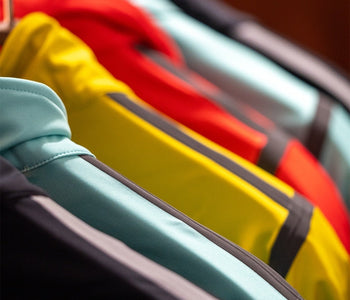Why Does Castelli Cycling Clothing Fit Small?
By Stan Portus – 10 March 2021
Ever wondered why your Castelli kit is a snugger fit than other brands? We thought we’d explain what’s behind Castelli sizing and why it fits the way it does.
Having been Castelli’s official UK home since 2006, we’ve had countless conversations with dealers, riders, and pros about what Castelli kit is right for them and often, what size is best for them too.
We’ve often come across people’s confusion around Castelli sizing, and sometimes their misconceptions too. So, we thought we’d explain what’s behind Castelli kit and why it fits the way it does by looking back to Castelli’s origins, the history of sizing, and what this means for you wearing Castelli today.

It Goes Back a Long Way
Older than the Tour de France and the Giro d’Italia, Castelli’s roots extend back to 1876 to a tailor’s shop in Milan run by Vittore Gianni. Gianni crafted clothes for the dignitary of Milan, provided the kit for Juventus and AC Milan, and was responsible for creating the first cycling-specific clothing in the 1910s for the 5-time Giro champion Alfredo Binda.
Tailoring is an essential part of Castelli’s origin story, and the development of tailoring and its relation to the mass production of clothes is also essential to understanding Castelli’s sizing.
At the time Gianni set up his tailor's shop, most clothing was produced for clients by hand and was made to measure. Standardised sizing began to appear gradually around the world from the late 19th Century, having previously only really existed for military uniforms. The first prototype for standardised men’s suit sizes appeared in Italy in the 1880s, but fully standardised sizes took some time to take shape.
There was a global push for standardised sizing from the 1930s onwards as manufacturers realised the value of making clothes to set measurements, which made mass-production more cost-effective and meant manufacturers could easily respond to consumer demand for affordable, on-trend designs.
By the late 1950s standardised sizing had come into effect in a numbers system, with set integers between sizes. For men’s sizing, in Italy, there were 4cm gaps between sizes which correlated directly to chest size.
When letter-based label sizing was created (S, M, L), the space between sizes reflected these 4cm integers and this was reflected in Castelli’s garments, giving them their fit.
However, behind the numbers and later the letter-based sizing system, manufacturers changed the actual size of their clothes leading to differences between brands.
Changes in Sizing
When sizing was beginning to be standardised there were differences between European sizing that used metric measurements and sizing that used Imperial measurements. Sizing that uses Imperial measurements is now common in the UK and remains pre-eminent in the USA.
Between sizes that used Imperial measurements, there was 2" (roughly 5cm) compared to the smaller gap of 4cm in European sizing. This immediately meant that Imperial clothes spanned a wider size range, but the difference was exaggerated even further from the 1970s onwards as clothing manufacturers began to increase the space between sizes in an attempt to flatter customers by pushing them up to 3" – 4", or around 7cm – 8cm.
This meant that when letter-based label sizes, known as alpha sizing, became more common there could be vast differences between a large in one country and a large in another, with sizing becoming increasingly different as you progressed up the size chart.
This issue became more pronounced as manufacturers and retailers realised the value of producing clothes in alpha sizing. Just as the original standardising of sizes reduced the range of garments a manufacturer would have to produce, fewer sizes in the alpha system reduced it even further. This was also aided with the changes in style with more relaxed fits and high stretch fabrics such as Lycra becoming common place.
What Does This Mean for Castelli?
As companies have started producing clothes in alpha sizing for global markets, it has led many manufacturers to implement a “global fit”, reducing the variation in production and decreasing the number of returns from people ordering multiple sizes online. In short, simplifying their business massively.
For Castelli, this means that despite keeping standard sizing and staying rooted to its origins, it diverges from Imperial style sizing which is becoming more and more common place, with fashion and bike brands alike adopting the enlarged sizing.
Same Range, Different Spacing
The difference in integers between Castelli sizing when compared to brands that use a more spaced size chart doesn’t mean Castelli only caters for one body type or style of riding.
Castelli’s sizing has virtually the same top-end size and bottom end size as other brands. What is different is the spread of sizes within the Castelli size guide.
Whereas some bike brands jump up sizes with bigger intervals, Castelli now spreads its sizes so there are smaller gaps between the smaller sizes and larger gaps the further you go up the chart.
Some brands take a “one integer for all” approach, but Castelli is well aware that different riders have different demands when looking for kit and the sizing curve of Castelli reflects that.
Castelli has found that this provides riders across the sizing spectrum with better choices. This is because there is closer variation for riders in the core sizes, so they can find a significantly better and more precise fit with Castelli, whilst in comparison, larger riders are given a wider range of sizing.
The Most Important Thing to Do
The most important thing to do when buying Castelli is to buy the right size for you by measuring yourself against the Castelli Size chart, rather than comparing Castelli to other brands in your wardrobe. Our stockists are more than happy to let you try Castelli on in store or use returns services if they are an online retailer.
Castelli Sizing Guide
Beyond sizes there are number of things to consider when purchasing Castelli apparel — or in fact any cycling apparel — to ensure the perfect fit. We’ve put together some essential things to bear in mind, from the unique demands different riding styles make on kit to finding the best wet weather garment for you.
Read More
Rouleur Live Gallery
We brought the best of performance cycling to Rouleur Live, showcasing ENVE, Cannondale, Castelli and more across two days in London.




